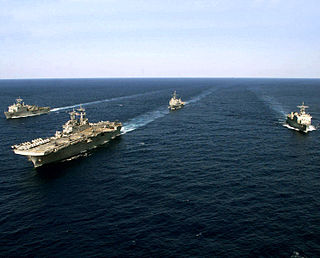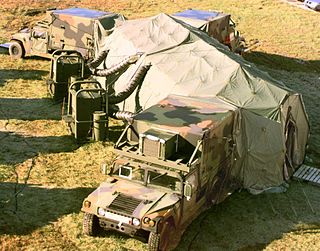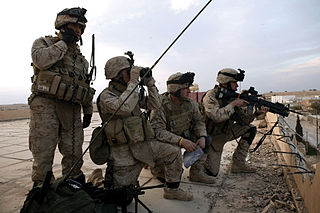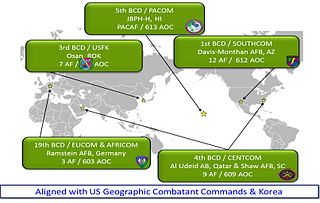Related Research Articles
The United States Armed Forces are the military forces of the United States. The armed forces consists of six service branches: the Army, Marine Corps, Navy, Air Force, Space Force, and Coast Guard. All six armed services are among the eight uniformed services of the United States.

A Marine expeditionary unit is the smallest air-ground task force (MAGTF) in the United States Fleet Marine Force. Each MEU is an expeditionary rapid reaction force ready to any crisis, whether it be disaster aid or a combat mission. Marine amphibious unit (MAU) was the name used until the late 1980s.

An amphibious ready group (ARG) of the United States Navy consists of a naval element—a group of warships known as an Amphibious Task Force (ATF)—and a landing force (LF) of U.S. Marines, in total about 5,000 people. Together, these elements and supporting units are trained, organized, and equipped to perform amphibious operations.
The Rapid Deployment Joint Task Force (RDJTF) is an inactive United States Department of Defense Joint Task Force. It was first envisioned as a three-division force in 1979 as the Rapid Deployment Force (RDF), a highly mobile rapid deployment force that could be rapidly moved to locations outside the normal overseas deployments in Europe and Korea. Its charter was expanded and greatly strengthened in 1980 as the RDJTF. It was inactivated in 1983, and re-organized as the United States Central Command (USCENTCOM).

The Tactical Air Control Party, commonly abbreviated TACP, is a small team of military personnel who provide coordination between aircraft and ground forces when providing close air support.

The Direct Air Support Center (DASC) is the principal United States Marine Corps aviation command and control system and the air control agency responsible for the direction of air operations directly supporting ground forces. It functions in a decentralized mode of operation, but is directly supervised by the Marine Tactical Air Command Center (TACC) or the Navy Tactical Air Control Center (NTACC). During amphibious or expeditionary operations, the DASC is normally the first Marine Air Command and Control System (MACCS) agency ashore and is usually categorized as the Ground Combat Element's (GCE's) senior Fire Support Coordination Center (FSCC). The DASC's parent unit is the Marine Air Support Squadron (MASS) of the Marine Air Control Group (MACG).

Air Naval Gunfire Liaison Company (ANGLICO) is an airborne fire support and liaison unit of the United States Marine Corps. The mission of ANGLICO is "To provide Marine Air-Ground Task Force (MAGTF) Commanders a liaison capability to plan, coordinate, and conduct terminal control of fires in support of joint, allied, and coalition forces. Per this mission statement, ANGLICOs are not designed to support U.S. Marine Corps maneuver elements. Instead, the doctrinal purpose of ANGLICO is to provide fire support and coordination in support of units adjacent to the MAGTF.

The II Marine Expeditionary Force is a Marine Air-Ground Task Force consisting of ground, air and logistics forces capable of projecting offensive combat power ashore while sustaining itself in combat without external assistance for a period of 60 days. The II Marine Expeditionary Force is commanded by a lieutenant general, who serves under U.S. Marine Corps Forces Command, providing Marine fighting formations and units to European Command, Central Command and Southern Command. The current Commanding General is Lieutenant General David A. Ottignon. The Deputy Commanding General is Brigadier General Andrew T. Priddy.
In the United States Marine Corps, a Marine air–ground task force is the principal organization for all missions across the range of military operations. MAGTFs are a balanced air–ground, combined arms task organization of Marine Corps forces under a single commander that is structured to accomplish a specific mission. The MAGTF was formalized by the publishing of Marine Corps Order 3120.3 in December 1963 "The Marine Corps in the National Defense, MCDP 1-0". It stated:

The United States Marine Corps is organized within the Department of the Navy, which is led by the Secretary of the Navy (SECNAV). The most senior Marine commissioned officer is the Commandant of the Marine Corps, responsible for organizing, recruiting, training, and equipping the Marine Corps so that it is ready for operation under the command of the unified combatant commanders. The Marine Corps is organized into four principal subdivisions: Headquarters Marine Corps, the Operating Forces, the Supporting Establishment, and the Marine Forces Reserve.

Marine Wing Communications Squadron 28 (MWCS-28) is a United States Marine Corps communications squadron. The squadron provides expeditionary communications for the aviation combat element of the II Marine Expeditionary Force. They are based at Marine Corps Air Station Cherry Point and fall under the command of Marine Air Control Group 28 and the 2nd Marine Aircraft Wing.

The Operational Test and Evaluation Force (OPTEVFOR) is an independent and objective agency within the United States Navy for the operational testing and evaluation (OT&E) of naval aviation, surface warfare, submarine warfare, C4I, cryptologic, and space systems in support Navy and Department of Defense acquisition programs.

Marine expeditionary unit (special operations capable) (MEU(SOC)) was a program created by the United States Marine Corps and the United States Navy in 1985 for Marine expeditionary units (MEU). As of 2013 the term MEU(SOC) is obsolete. The program enhanced MEUs providing them with additional training and equipment to become certified as special operations capable with a Maritime Special Purpose Force (MSPF). The designation special operations capable was unique to the Marine Corps and meant in relation to special operations. The role of a MEU(SOC) however was not equivalent to the special operations role of special operations forces. Although considered special operations capable a MEU(SOC) did not form part of the United States Special Operations Command (USSOCOM) established in 1987 or the United States Marine Forces Special Operations Command (MARSOC) later established in 2006.
The United States Marine Corps is tasked by Department of Defense directive to "conduct complex expeditionary operations in the urban littorals and other challenging environments" and "conduct amphibious operations, including engagement, crisis response, and power projection operations to assure access." Before 2006, the Marine Corps was the only branch of the Armed Forces that did not have any of its special warfare elements participating in the United States Special Operations Command (USSOCOM), due to confining its special operations capabilities only for the purpose to the Fleet Marine Force.
The reconnaissance mission within the United States Marine Corps is divided into two distinct but complementary aspects; Marine Division Recon and Force Reconnaissance.

The Marine Personnel Carrier (MPC) is a wheeled armored personnel carrier under development for acquisition by the United States Marine Corps. The program was canceled in 2013 but resurrected in 2014 as part of phase one of the Amphibious Combat Vehicle.

The United States armed forces classify reconnaissance missions as "close" or "short-range"; "distant" or "medium-range"; and "deep" or "long-range".

The Battlefield Coordination Detachment (US Army), or BCD, is the senior United States Army liaison element of the Army Air Ground System. The BCD serves as a bridge between the senior US Army headquarters element and the senior Air Force headquarters in each respective US combatant command or theater of operations. The BCD enables the coordination of Army-Air Force mission command, fire support, integrated air and missile defense, intelligence sharing, airspace management, and airlift. Additional space, cyber, and electronic warfare augmentation allow the BCD to further enable the designated Army force commander across the complete spectrum of warfare.
The Marine Air Command and Control System (MACCS) is the aviation command and control agencies of the United States Marine Corps that provide the Aviation Combat Element (ACE) commander with the means to monitor, supervise, and influence aviation operations in support of the Marine Air-Ground Task Force. The command and control agencies of the MACCS are provided by the squadrons and battalions of the Marine Air Control Groups that are present within each Marine Air Wing. The capabilities resident within the MACCS allow the MAGTF commander to safely conduct aviation operations, facilitate timely maneuver and prosecution of fires and ultimately retain full control of their entire area of operations. MACCS agencies are also responsible for coordinating Marine Corps aviation operations with joint, multinational and civil aviation.
References
- ↑ United States Marine Corps Command (2015-03-31). The Marine Corps Assault Support Community: The Requirement to Develop and Maintain the Capability to Operate in the Mountainous Clime and Place. CreateSpace Independent Publishing Platform. ISBN 978-1-5115-2464-3.
 This article incorporates public domain material from websites or documents of the United States Marine Corps .
This article incorporates public domain material from websites or documents of the United States Marine Corps .